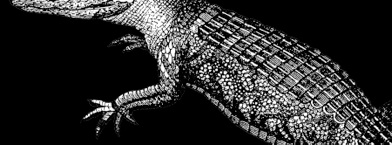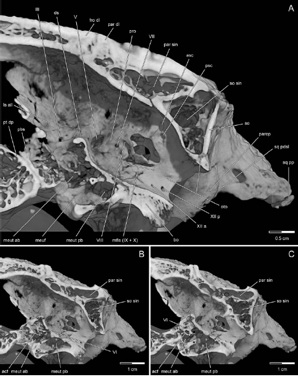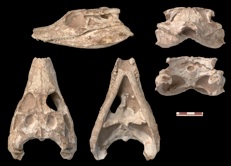 |  |
| |
Shamosuchus djadochtaensis | Eusuchian Origins and Morphological Evolution Crocodyliforms – crocodylians and their extinct relatives – have an excellent fossil record. They are ubiquitous in warm-climate continental and nearshore deposits from the Early Jurassic to the present. They were among the dominant land predators and (possibly) herbivores in some regions and part of the marine reptile radiations of the Mesozoic. Eusuchians are the derived group of crocodyliforms that mark the beginning of the “modern crocodylian” morphology. Eusuchians have a derived bony secondary palate and procoelous vertebrae with ball-and-socket joints. I’m currently working with Chris Brochu at the University of Iowa and Diego Pol at the Museo Paleontológico Egidio Feruglio on expanding the morphological datasets used for examining eusuchian phylogeny. Additionally, we have begun to re-examine key eusuchian taxa like Shamosuchus and Acynodon shown to the left. |
| |
| Gondwanan Crocodyliform Phylogeny The Cretaceous Period witnessed as huge radiation of crocodyliforms that lived in the southern landmasses. This Gondwanan radiation was comprised almost exclusively by a group called Notosuchia. Notosuchians explored a wider range of niches than modern crocodylians do--exploring small terrestrial omnivorous and herbivorous roles (e.g., Araripesuchus, Simosuchus) as well as becoming large macropredators (e.g., sebecosuchians). |
Araripesuchus tsangatsangana |
 | Much of my work on crocodyliform phylogenetics has focused on this notosuchian clade in an effort to understand their evolutionary and biogeographic histories. I’ve been particularly lucky to have the opportunity to work on the oftentimes bizarre Malagasy crocodyliform fauna. Taxa have have described include a new species of Araripesuchus and the enigmatic broad-snouted Mahajangasuchus (Turner and Buckley, 2008) and the pug-nosed Simosuchus clarki (Turner and Sertich, 2010; Kley et al., 2010). Much of this work has utilized CT scans to visualize and described the poorly known internal cranial anatomy of most notosuchians. Moving forward I am interested in establishing a large comparative dataset of Gondwanan crocodyliform cranial anatomy, which could be used for expanding character analysis for the clade. |




